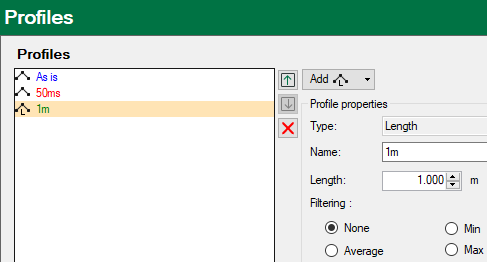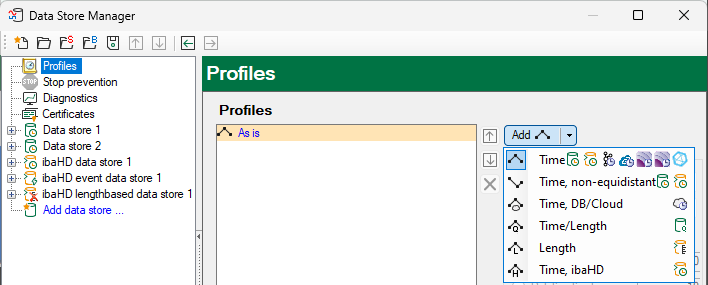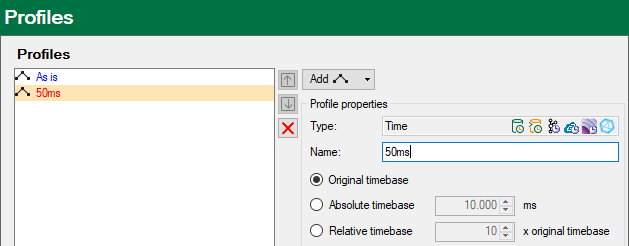If not happened yet, please define at first the storage profiles, that you want to use for the HD data store. If appropriate profiles for normal ibaPDA data stores are already designed, you can also use them for time-based HD stores. You can create as many profiles as you want.
-
Click on the node Profiles in the left part of the dialog.
-
Select a profile type in the drop-down list from the button <Add>.
Usually you will use the type "Normal profile" for time-based HD data stores and the type "Length" for length-based stores. Use the "Time, ibaHD" profile for the acquisition of non-equidistant data.
-
Give the profile a unique name, e.g. “50ms” if the data should be stored in the 50 ms grid.
-
If you have set the "Time, ibaHD" profile type, select the Mode:
-
As is: The signals are stored as they are. This means that equidistant signals are stored equidistantly, non-equidistant signals are stored non-equidistantly.
-
Equidistant: The signals are resampled. The new time base can be configured as an absolute time base or as a multiple of the original time base. Filters can be used to determine which value is to be saved. This profile has the same options as the standard "Time" profile.
-
Non equidistant: Each time the value of the trigger signal changes, a value is saved. In the case of a digital trigger signal, a value is therefore saved for both the rising and falling edge. The sampling time stamp can be taken from the source signal or from the trigger signal. This is only important if the time base of the source and trigger signal is different. This profile has the same options as the standard "Time, non-equidistant" profile.
-
-
Set now the required timebase (here: 50 ms) or length base (in m) and activate a filter option, if necessary. You can set length values from 1 mm to several meters.
Profile type “Time”, Absolute timebase “50 ms”

In this example, the average value of all values recorded in the recording interval of 50 ms is saved.
Profile type “Length”, Length base “1 m”

Signals which are recorded with this profile will later only show one sample per meter in the ibaPDA trend graph.
-
If you want to customize the time base of the aggregation levels, select the Aggregation mode "Custom aggregation timebases".
Note

Note the following restrictions for the time base of each aggregation level:
-
You can define a maximum of 5 aggregation levels.
-
At least one aggregation level must have a timebase > 1 minute.
-
The largest timebase must be < 7 days.
-
Each level must be a multiplication of the level below. For example, level 1 with a timebase of 500 ms and level 2 with a timebase of 20.35 seconds are not permitted. iba AG recommends that the factor between the timebases of successive aggregation levels is between 10 and 100.
-
The configuration of the user-defined aggregation levels is independent of the profile mode.
-
Note |
|
|---|---|
|
Please note that the resolution of the length data has an influence on the possible zoom factor for the zoom out of the HD trend graph. A length-based HD trend graph can display maximum 50,000 samples per signal. The smaller the length base, the shorter is the total length that can be displayed in the trend graph. If, for example, a length base of 1 mm has been selected, then it is not possible to zoom out further than 50 m. The measurement for a very long product, e.g. a rolled steel strip with a length of several hundred meters, cannot be displayed completely in a single trend graph. If you rather select a storage profile with a length base of 0.5 m, up to 25 km can be displayed in a trend graph. |
|
Other documentation |
|
|---|---|
|
For further information on the storage profiles see the ibaPDA manual. |
|

